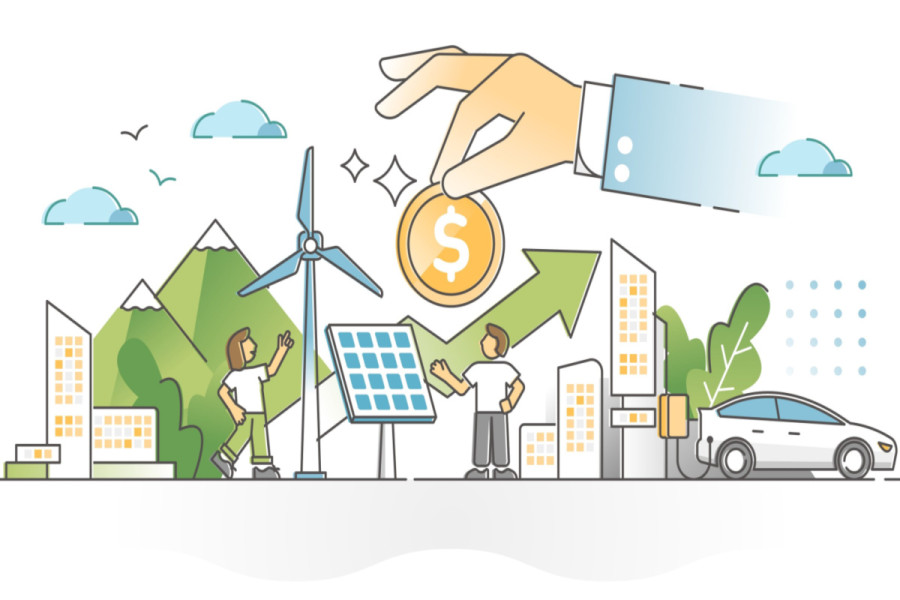Columns
Climate finance dilemma
It would be unwise only to demand climate finance as grants without prioritising areas of investment.
Subash Pandey
The adoption of the Paris Agreement in 2015, which aims to limit the temperature rise below 2 degrees Celsius by the end of this century, is one of the greatest achievements in the three decades of international climate negotiations. Nationally Determined Contributions (NDCs) are some of the key elements of the agreement, and their implementation will be crucial in the coming decades to achieve both common global and national climate goals. To fulfil its obligation to the United Nations Framework Convention on Climate Change (UNFCCC), Nepal submitted its first NDC in 2016 and a more ambitious second NDC in 2020 to reach net zero by 2050. The second NDC has both mitigation and adaptation targets for the short-term (2025), medium-term (2030), and long-term (2050) and its implementation is estimated to cost $78.4 billion. This is nearly double the size of Nepal’s gross domestic product (GDP).
However, Nepal still lacks a clear strategy for financing these ambitious climate projects. The country plans to invest just $3.4 billion with its internal sources to achieve its sole unconditional goal, i.e., to generate 5,000 megawatts of electricity by the end of 2025. Nepal anticipates climate finance of nearly $25 billion to achieve its mitigation-related conditional goals of NDC. Furthermore, to accomplish the adaptation-related goals as mentioned in its National Adaptation Plan, Nepal estimates it will need $21 billion by 2030 and $46.4 billion by 2050. It intends to cover $1.5 billion with its internal resources and seeks $45.9 billion from external resources.
The important thing is that Nepal wants all the climate finance only as a grant from external sources. However, looking at the international scenario and global competition for climate finance, it is almost impossible for Nepal to receive climate financing only as a grant. Given that, the country needs a clear financing strategy that identifies productive sectors that yield returns on investments with loans.
Climate finance for adaptation and mitigation
There were protests in Nepal when it signed a $100 million concessional loan with the World Bank for “green, resilient, and inclusive development” (GRID) in August 2022. Policymakers, academics, and climate activists expressed their concerns and disappointment with the climate loan. They argued unequivocally that climate finance should only come as grants, not as loans. It is not difficult to understand their concerns about climate loans as loans would be an injustice to people in vulnerable countries who contribute little to global warming. Based on the “polluter pays” principle, it is a valid argument that Nepal should receive only the grants to achieve targets of climate adaptation as communities in Nepal will be adapting to the problems they did not cause. Additionally, investments in climate adaptation do not yield returns in the future.
It would be unwise and naive only to demand grants without prioritising areas of investment with the potential to generate profits in the future with loans as well. Current investments in climate mitigation have the opportunity to generate profit in the future. Furthermore, as previously stated, the reality of the current distribution of climate finance reveals the bitter truth that even the least developed countries (LDCs) like Nepal will not receive all the climate finance only as grants. Nepal needs to prioritise the sectors where it would benefit even from the loans. Saying “no” to all climate loans might prove costly for the country.
Prioritisation of sectors
Nepal should benefit from the concessional loans provided by multilateral financial institutions aimed at helping LDCs in achieving their development objectives. The country could use such loans to invest in climate mitigation goals that would benefit it economically and geopolitically and also help it become energy independent. Nepal’s second NDC, for instance, has ambitious conditional climate goals. Some of them include generating 15,000 megawatts by the end of 2030, increasing the sales of e-vehicles to cover 90 percent of all private passenger vehicles and 60 percent of all four-wheeler public passenger vehicles by 2030 and ensuring that 25 percent of Nepalis use electric stoves as their primary cooking medium by that year.
There is no cost-benefit analysis to tell the benefit of each dollar spent in the clean energy sector in Nepal. But the investment in the energy sector would benefit Nepal enormously. One example of this potential benefit comes from phasing out fossil fuels, as Nepal imports billions of petroleum products from India every year. Another is the grounded Sajha’s electric buses because of a lack of necessary charging infrastructure. Additionally, there are other co-benefits associated with investments in clean energy. Nepal ranked 178th out of 180 countries regarding air quality, and 5,000 deaths in Kathmandu in 2019 were attributable to air pollution. A World Bank report estimates air pollution costs around 3.5 percent of Nepal’s GDP. Vehicle emissions and smoke from brick kilns are the main culprits of air pollution here. These examples highlight the low-hanging fruits with potential economic benefits for investment, even with concessional climate loans.
Recommendations for Nepal
There are currently 46 least-developed countries like Nepal. Based on the principle of equity, these LDCs have submitted NDCs with almost all conditional targets. Additionally, emerging developing countries like India, Indonesia, and South Africa also have some conditional components in their NDCs and would compete for the same climate finance. Furthermore, one analysis shows that the implementation of 51 NDCs, many of which are from LDCs, requires $1.5 trillion. This figure is way below the $100 billion climate finance promised by developed countries in climate finance each year for poor countries.
The LDCs receive climate finance primarily for adaptation, whereas high-emitting emerging countries receive climate finance for mitigation. Evidence shows that around 65 percent of climate-related finance flows to middle-income countries, compared to 20 percent to LDCs. Mitigation mobilised 58 percent of the total climate finance in 2020, largely flowing to countries with high and fast-growing emissions. For instance, South Africa, an emerging economy, approved an investment plan of $8.5 billion to expedite its transition from coal to clean energy. Just 3 percent of that finance will be delivered as grants; the rest will come as “concessional and commercial loans.” Indonesia has a similar story to South Africa.
No single country will certainly receive all climate finance as grants to achieve their climate pledges. It is, therefore, wise to prioritise sectors where climate loans make sense for investment based on the national interests of Nepal. Nepal should not receive climate loans for adaptations that do not ensure a return on investment, but rejecting all loans will not move the needle on climate actions.




 15.69°C Kathmandu
15.69°C Kathmandu















